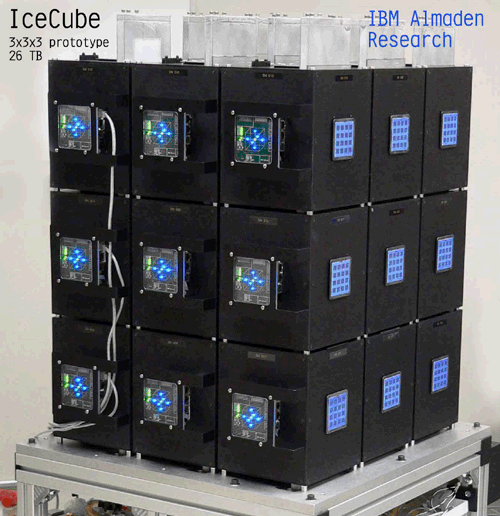
 | Operators of large datacenters are in fairly good agreement what their most difficult issues are. At the top of their list is the difficulty of managing large, complex systems. Other issues are scalability, cost and environmental issues such as cooling, power, floor space and noise. Icecube, with its associated software project (Kybos) is a new system architecture (formally called Collective Intelligent Bricks) to address most of these problems. It is a rather unusual, highly modular hardware structure, where all components are packed into Lego(TM)- like bricks and the system is a big cube made from of these bricks. Bricks communicate through 'capacitve coupling' through their surfaces, forming a true 3-dimensional high-speed network. Icecube specific software manages the whole system with a minimum of human invention. The first IceCube prototype, a 3x3x3 brick storage server with 26 Terabyte capacity, was completed in January 2005 and operates as planned. The talk describes the motivation and details of the architecture and the highlights of the software. |
About the speaker:

|
Winfried W. Wilcke is a Program Director at the IBM Almaden Research
Facility. He received a PhD in Nuclear Physics in 1976 and worked in
this field at the University of Rochester, Lawrence Berkeley Lab and Los
Alamos LAMPF, co-authoring about 100 papers. In 1983 he joined IBM
Research in Yorktown Heights. There he managed two projects (Victor and
Vulcan), which were Research precursors to the IBM SP series of massively
parallel supercomputers. During the last ten years, many of the 500
fastest supercomputers in the world were SP machines.
In 1991, he participated in a silicon valley startup, HaL Computers,
where he was initially Director of Architecture and later CTO. HAL was
instrumental in creating -jointly with Sun--the 64-bit Sparc
architecture, which became the base of Sun's system product line. HAL
grew to over 400 employees and was eventually acquired by Fujitsu. In
1996 Winfried left HAL for an extended sailing/diving trip. In the late
nineties, he rejoined IBM Research in Almaden, California, participating
in the Transmeta startup effort. Three years ago he launched the IBM
IceCube project, which is a highly scalable architecture for
data-intensive storage and computing. The first IceCube was completed in
2005. His hobbies are collecting airplanes and flying, sailing and underwater video making. |
Contact information:
Winfried W. Wilcke
Program Director, Silicon Valley IBM Research Division
Email: winfriedwilcke@us.ibm.com